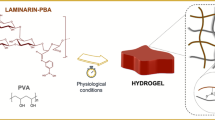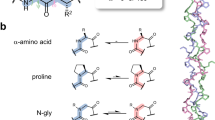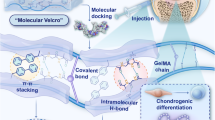Abstract
Collagen-mimetic peptides and lipopeptides are widely used as substrates for matrix degrading enzymes, as new biomaterials for tissue engineering, as drug delivery systems and so on. However, the preparation and subsequent purification of these peptides and their fatty-acid conjugates are really challenging. Herein, we report a rapid microwave-assisted, solid-phase synthetic protocol to prepare the fatty-acid conjugated, triple-helical peptides containing the cleavage site for the enzyme matrix metalloproteinase-9 (MMP-9). We employed a PEG-based resin as the solid support and the amino acids were protected with Fmoc- and tert-butyl groups. The amino acids were coupled at 50 °C (25 W of microwave power) for 5 min. The deprotection reactions were carried out at 75 °C (35 W of microwave power) for 3 min. Using this protocol, a peptide containing 23 amino acids was synthesized and then conjugated to stearic acid in 14 h.
This is a preview of subscription content, access via your institution
Access options
Subscribe to this journal
Receive 12 print issues and online access
$259.00 per year
only $21.58 per issue
Buy this article
- Purchase on Springer Link
- Instant access to full article PDF
Prices may be subject to local taxes which are calculated during checkout













Similar content being viewed by others
References
Nelson, D.L. & Cox, M.M. Principles of Biochemistry 126–129 (W.H. Freeman and Company, New York, 2005).
Mu, C., Li, D., Lin, W., Ding, Y. & Zhang, G. Temperature induced denaturation of collagen in acidic solution. Biopolymers 86, 282–287 (2007).
Devlin, T.M. Textbook of Biochemistry with Clinical Correlations 100–103 (Wiley-Liss, Hoboken, New Jersey, 2006).
Brodsky, B., Thiagarajan, G., Madhan, B. & Kar, K. Triple-helical peptides: an approach to collagen conformation, stability and self-association. Biopolymers 89, 345–353 (2008).
Farndale, R.W. et al. Cell-collagen interactions: the use of peptide toolkits to investigate collagen-receptor interactions. Biochem. Soc. Trans. 36, 241–250 (2008).
Rydlova, M. et al. Biological activity and clinical implications of the matrix metalloproteinases. Anticancer Res. 28, 1389–1398 (2008).
Fingleton, B. Matrix metalloproteinases as valid clinical targets. Curr. Pharm. Design 13, 333–346 (2007).
Tu, G., Xu, W., Huang, H. & Li, S. Progress in the development of matrix metalloproteinase inhibitors. Current Med. Chem. 15, 1388–1395 (2008).
Nalivaeva, N.N., Fisk, L.R., Belyaev, N.D. & Turner, A.J. Amyloid-degrading enzymes as therapeutic targets in Alzheimer's disease. Curr. Alzheimer Res. 5, 212–224 (2008).
Al Mofleh, I.A. Severe acute pancreatitis: pathogenetic aspects and prognostic factors. World J. Gastroenterol. 14, 675–684 (2008).
Muroski, M.E. et al. Matrix metalloproteinase-9/gelatinase B is a putative therapeutic target of chronic obstructive pulmonary disease and multiple sclerosis. Curr. Pharm. Biotechnol. 9, 34–46 (2008).
Minnond, D. et al. Differentiation of secreted and membrane-type matrix metalloproteinase activities based on substitutions and interruptions of triple-helical sequences. Biochemistry 46, 3724–3733 (2007).
Minond, D. et al. The roles of substrate thermal stability and P2 and P1 subsite identity on matrix metalloproteinase triple helical peptidase activity and collagen specificity. J. Biol. Chem. 281, 38302–38313 (2006).
Malkar, N.B., Lauer-Fields, J.L., Juska, D. & Fields, G.B. Characterization of peptide-amphiphiles possessing cellular activation sequences. Biomacromolecules 4, 518–528 (2003).
Forns, P., Lauer-Fields, J.L., Gao, S. & Fields, G.B. Induction of protein-like molecular architecture by monoalkyl hydrocarbon chains. Biopolymers 54, 531–546 (2000).
Gore, T., Dori, Y., Talmon, Y., Tirrell, M. & Biano-Peled, H. Self-assembly of model collagen peptide amphiphiles. Langmuir 17, 5352–5360 (2001).
Rezler, E.M., Khan, D.R., Tu, R., Tirrell, M. & Fields, G.B. Peptide-mediated targeting of liposomes to tumor cells. Methods Mol. Biol. 386, 269–298 (2007).
Cejas, M.A. et al. Thrombogenic collagen-mimetic peptides: self-assembly of triple helix-based fibrils driven by hydrophobic interactions. Proc. Natl. Acad. Sci. USA 105, 8513–8518 (2008).
Rezler, E.M. et al. Targeted drug delivery utilizing protein-like molecular architecture. J. Am. Chem. Soc. 129, 4961–4972 (2007).
Sarkar, N. et al. A matrix metalloproteinase assisted triggered release of liposomal contents. Bioconjugate Chem. 19, 57–64 (2008).
Elegbede, A.I. et al. Mechanistic studies on the triggered release of liposomal contents by matrix metalloproteinase-9. J. Am. Chem. Soc. 130, 10633–10642 (2008).
Banerjee, J. et al. Release of liposomal contents by cell-secreted matrix metalloproteinase-9. Bioconjugate Chem. 20, 1332–1339 (2009).
Palasek, S.A., Cox, Z.J. & Collins, J.M. Limiting racemization and aspartimide formation in microwave-enhanced Fmoc solid phase peptide synthesis. J. Pept. Sci. 13, 143–148 (2007).
Santagada, V. et al. Microwave assisted synthesis: a new technology in drug discovery. Mini-Rev. Med. Chem. 9, 340–358 (2009).
Collins, J.M. & Leadbeater, N.E. Microwave energy: a versatile tool for the biosciences. Org. Biomol. Chem. 5, 1141–1150 (2007).
Polshettiwar, V. & Varma, R.S. Microwave-assisted organic synthesis and transformations using benign reaction media. Acc. Chem. Res. 41, 629–639 (2008).
Bacsa, B., Horvati, K., Bosze, S., Andreae, F. & Kappe, C.O. Solid-phase synthesis of difficult peptide sequences at elevated temperatures: a critical comparison of microwave and conventional heating technologies. J. Org. Chem. 73, 7532–7542 (2008).
Saludes, J.P., Ames, J.B. & Gervay-Hague, J. Synthesis and structural characterization of sialic acid-glutamic acid hybrid foldamers as conformational surrogates of α-2,8-linked polysialic acid. J. Am. Chem. Soc. 131, 5495–5505 (2009).
Galanis, A.S., Albericio, F. & Grotli, M. Enhanced microwave-assisted method for on-bead disulfide bond formation: synthesis of α-conotoxin MII. Biopolymers 92, 23–34 (2009).
Katritzky, A.R., Haase, D.N., Johnson, J.V. & Chung, A. Benzotriazole-assisted solid-phase assembly of Leu-enkephalin, amyloid β segment 34–42, and other 'difficult' peptide sequences. J. Org. Chem. 74, 2028–2032 (2009).
Sabatino, G. & Papini, A.M. Advances in automatic, manual and microwave-assisted solid-phase peptide synthesis. Curr. Opin. Drug Discov. Devel. 11, 762–770 (2008).
Cemazar, M. & Craik, D.J. Microwave-assisted Boc-solid phase peptide synthesis of cyclic cysteine-rich peptides. J. Peptide Sci. 14, 683–689 (2008).
Murray, J.K. & Gellman, S.H. Parallel synthesis of peptide libraries using microwave irradiation. Nat. Protoc. 2, 624–631 (2007).
Basca, B. & Kappe, C.O. Rapid solid-phase synthesis of a calmodulin-binding peptide using controlled microwave irradiation. Nat. Protoc. 2, 2222–2227 (2007).
Persikov, A.V., Xu, Y. & Brodsky, B. Equilibrium thermal transitions of collagen model peptides. Prot. Sci. 13, 893–902 (2004).
Acknowledgements
This research was supported by the NIH grant 1R01 CA113746, and NSF DMR-0705767 to S.M. J.B. is supported by a Graduate School Doctoral Fellowship from the North Dakota State University. J.B.S. thanks the support of the proteomics core facility by NIH Grant P20 RR016741 from the INBRE Program of the NCRR.
Author information
Authors and Affiliations
Contributions
S.M. conceived the idea and supervised the project; J.B. and A.J.H. carried out the lipopeptide synthesis; J.B.S. and W.W.M. recorded the mass spectra; and S.M. and J.B. wrote the manuscript.
Corresponding author
Supplementary information
Supplementary Methods
Detailed operational steps the CEM Liberty peptide synthesizer performs for the single coupling, double coupling and cleavage from the resin. (PDF 75 kb)
Rights and permissions
About this article
Cite this article
Banerjee, J., Hanson, A., Muhonen, W. et al. Microwave-assisted synthesis of triple-helical, collagen-mimetic lipopeptides. Nat Protoc 5, 39–50 (2010). https://doi.org/10.1038/nprot.2009.195
Published:
Issue Date:
DOI: https://doi.org/10.1038/nprot.2009.195
Comments
By submitting a comment you agree to abide by our Terms and Community Guidelines. If you find something abusive or that does not comply with our terms or guidelines please flag it as inappropriate.



